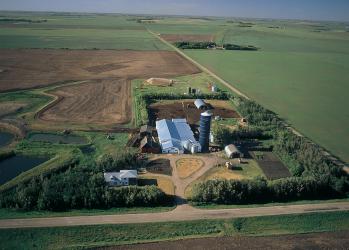
Milk production for sale to processing plants began in Saskatchewan in the late 1890s. The number of dairy cows in Saskatchewan peaked at 590,000 in 1935, and has declined steadily since that time. In 1935 most of the milk produced was used to make butter; the skim milk was kept on the farm and used as a protein and vitamin source for pigs and poultry. As refrigeration and transportation systems improved, cream production was gradually replaced by sale of whole milk to processing plants with improved sanitary and product quality standards. By 2003 the number of milk cows had declined to 31,000, and cream shipping had been phased out. Rural electrification, which took place mainly in the 1950s, had a significant impact on the dairy industry. Bulk handling milk began in Ontario in 1953, and was introduced into western Canada soon after that.
The technology to freeze semen was developed in the 1950s, which greatly expanded the use of artificial insemination (AI) in dairy cattle. The 1950s also saw the development of computer programs for record keeping and analysis of the production of daughters of bulls. This new technology allowed identification and widespread use of superior bulls. The first barns in western Canada housed cows in individual stalls; but in the 1950s group housing in the free stall system was introduced, with cows being moved from the stalls to a milking parlour. There was a gradual evolution of mechanization and housing systems in the 1970s and 1980s: new types of housing were introduced in the mid-1990s which greatly improved barn ventilation through use of much higher roofs and the adoption of natural updraft ventilation.
In 2002 there were just over one million milk cows in Canada, on 18,600 dairy farms. About 81% of these dairy farms are located in Ontario and Quebec; 14% are in the western provinces, and 5% in the Atlantic provinces. In 2002 the dairy farms in Saskatchewan numbered 300. There is a continuing decline in the number of dairy farms, accompanied by an increase in number of cows and milk production per cow. Average production per cow is now 9,000 kg annually, or twice the 1960 level. The genetic improvement of dairy cattle for milk production as well as physical soundness and removal of genetic defects is a joint effort involving Agriculture and Agri-Food Canada, the breed associations, and a number of organizations that are members of the Canadian Dairy Network. About 95% of the dairy cattle in Saskatchewan belong to the Holstein breed. There are also small numbers of Ayrshire and Jersey dairy cattle in the province, but very few of other breeds such as Guernsey, Brown Swiss, or Shorthorn. The reason for the popularity of the Holstein breed is its high milk production and the pricing system which favours the low-fat composition of Holstein milk. Bull calves from the Holstein breed enter the feedlot system and are finished for market at a slightly heavier weight than traditional beef breeds.
All dairy animals are individually identified, and detailed milk production composition and physical type characteristics are recorded on many dairy farms. Most dairy herds have adopted a mixed-ration feeding system in which forages and concentrate ingredients are blended, and sufficient water or wet feeds are included to increase the moisture content to about 45%. In Saskatchewan the main forages are whole-plant barley silage and alfalfa hay or silage. The main cereal grain used in the concentrate is barley, and the protein supplements include canola meal, soybean meal, corn gluten meal, and wheat distillers grain. Trace mineral supplementation suitable for specific regions has been developed.
In the year 2000 total Canadian farm cash receipts from the dairy sector amounted to $4.1 billion, with about $130 million in Saskatchewan. Canada exports dairy cattle and other genetic material in the form of embryos and semen. In addition to the Canadian Dairy Commission, there are a number of important organizations involved in the dairy industry. These include Dairy Farmers of Canada, which is a national policy, lobby, and dairy product promotion organization; individual farm milk production quotas are set by provincial regulatory boards according to Canadian Dairy Commission guidelines. The Canadian Dairy Network is involved in the genetic evaluation of Canadian dairy bulls and cows. This function was previously carried out by Agriculture and Agri-Food Canada, but was formed as a private organization in 1995 with the board of directors from the artificial insemination industry, the breed associations, and the milk recording agencies.
David A. Christensen